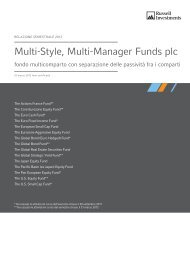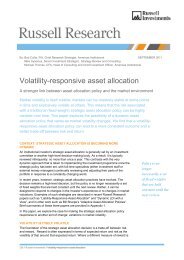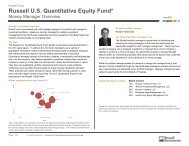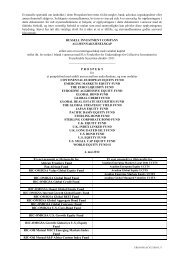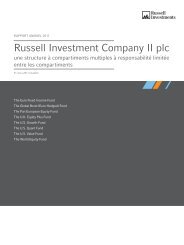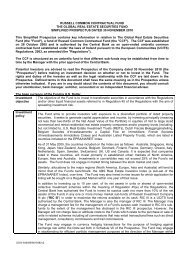Implementing LDI with swaptions - Russell Investments
Implementing LDI with swaptions - Russell Investments
Implementing LDI with swaptions - Russell Investments
Create successful ePaper yourself
Turn your PDF publications into a flip-book with our unique Google optimized e-Paper software.
EXECUTIVE VIEW<br />
Dealing <strong>with</strong> change: Applying<br />
the lessons of a thousand clichés<br />
Dear Readers,<br />
Like it or loathe it, there’s no avoiding change. We are, of course, supposed to embrace it,<br />
to never stop learning, and to apply lots of other advice that has unfortunately lost its luster<br />
through overuse and passed into the realm of cliché—which doesn’t make it bad advice. So,<br />
although it wins us no points for the originality of the theme, change is the thread that runs<br />
through this issue of Communiqué.<br />
Change comes in many forms. We are slowest to accept change when it challenges our old<br />
way of seeing the world, when it calls into question long-held opinions or practices that have<br />
become part of our fabric. For example, for many years institutional investors saw strategic<br />
asset allocation as fixed asset allocation, but it doesn’t have to be. One of the biggest themes<br />
in our work <strong>with</strong> institutional investors over the past couple of years has been a much more<br />
dynamic approach to asset allocation—all the while retaining the discipline and long-term<br />
perspective that distinguish the strategic from the tactical. The catalyst that made this change<br />
possible was liability-responsive asset allocation: a dynamic—but strategic—approach that<br />
opened the door to the possibility of other forms of dynamic strategic allocation.<br />
In this issue, we pick up the theme of volatility-responsive asset allocation that was introduced<br />
in last quarter’s Communiqué and look at the evidence that adjusting asset allocation in<br />
response to market volatility can help in the management of risk. Lisa Cavallari and Marty<br />
Jaugietis take a look at <strong>swaptions</strong>, an emerging tool for <strong>LDI</strong> managers, describing how these<br />
instruments work and how they can help manage interest rate exposure for defined benefit<br />
plans. Our Q&A column turns to the world of defined contribution and looks at how target<br />
date funds (TDFs) are already changing as the first generation of TDF products is replaced<br />
by a more flexible design approach. This quarter’s Opinion article looks at another type of<br />
change—climate change—as Greg Liddell argues the case for why investors need to pay<br />
more attention than they do.<br />
Thank you for reading,<br />
Bob Collie<br />
Bob Collie,<br />
Chief Research Strategist, Americas Institutional<br />
p / 3





